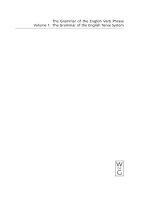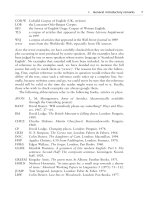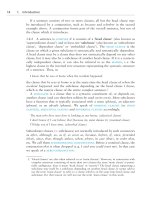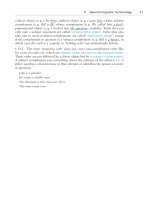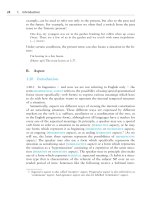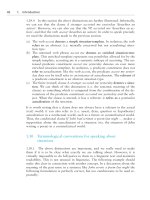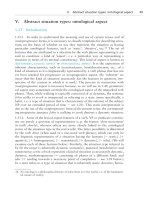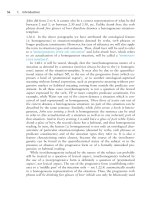The grammar of the english verb phrase part 5 pdf
Bạn đang xem bản rút gọn của tài liệu. Xem và tải ngay bản đầy đủ của tài liệu tại đây (73.66 KB, 7 trang )
II. General linguistic terminology 21
a direct object (e. g. I hit him), indirect object (e. g. I gave him a kite), subject
complement (e. g. Bill is ill), object complement (e. g. We called him a fool),
prepositional object (e. g. I looked into the question carefully). Verbs that can
only take a subject argument are called ‘intransitive verbs’. Verbs that also
take one or more nominal complements are called ‘
transitive verbs’, except
if the complement in question is a subject complement (e. g. Bill is a nurse), in
which case the verb is a ‘copula’ or ‘linking verb’ (see immediately below).
1.13.2 The term ‘transitive verb’ does not cover one-complement verbs like
be, seem, become, etc. which are linking verbs or copulas or copular verbs.
These verbs are not followed by a direct object but by a
subject complement.
A subject complement says something about the referent of the subject, i. e. it
either ascribes a characteristic to that referent or identifies the person or entity
in question.
John is a plumber.
He seems a reliable man.
The chairman is that man over there.
This wine tastes sour.
22 1. Introduction
III. Meaning categories expressed by verb forms
There are four systems of the verb phrase which grammaticalize meaning, but
only three will prove relevant to the discussion of tense, namely tense itself,
grammatical aspect, and mood / modality. (The category that is not relevant
to tense is voice.) These three areas of grammatical meaning interact with one
another and therefore need to be considered together. Apart from them, this
chapter also pays attention to ‘lexical aspect’ and ‘actualization aspect’ because
these systems of meaning often interact with tense, and are therefore essential
to any complete discussion of tense.
A. Tense
1.14 Introduction
1.14.1 We should make a careful distinction between ‘tense’ and ‘time’. Time
is an extralinguistic category. That is, it exists independently of language. Tense
is a linguistic concept: it denotes the form taken by the verb to locate the
situation referred to in time, i. e. to express the temporal relation between the
time of the situation in question and an ‘orientation time’ which may be either
the ‘temporal zero-point’ (which is usually the time of speech Ϫ see 2.4) or
another orientation time that is temporally related to the temporal zero-point.
For example, in the sentence John confessed that he had stolen the money the
past tense form confessed locates the time of the confession in the past, i. e. in
a time-zone which lies completely before the zero-point. The past perfect form
had stolen expresses that the theft was committed before the confession. The
time of the confession is thus the orientation time to which the time of the
theft is represented as anterior by the past perfect. In sum, verb forms are tense
forms if they relate a situation time directly or indirectly to the zero-point.
1.14.2 The traditional
names for the tenses in English are:
(a) ‘Present tense’, e. g. I live here.
(b) ‘Past tense’ or ‘preterite’, e. g. I made a mistake.
(c) ‘Future tense’, e. g. I will do it.
(d) ‘Present perfect’, e. g. We haven’t met yet.
(e) ‘Past perfect’ or ‘pluperfect’, e. g. I hadn’t expected this.
(f) ‘Conditional tense’, e. g. We would soon find out.
(g) ‘Conditional perfect’, e. g. She would have left by then.
Three points should be borne in mind here. First, only indicative forms are
tensed Ϫ see 1.10. Second, all tenses have nonprogressive and progressive
III. Meaning categories expressed by verb forms 23
forms: I live here and I’m living here are both sentences in the present tense.
Thirdly, when the verb form is a complex form involving one or more auxilia-
ries, it is the first auxiliary (the so-called
operator) that is marked for tense,
not the main verb. For example:
John {is / was / has been / will be} blamed for the accident.
He {doesn’t / didn’t / won’t} know the answer.
In this context, ‘marked for tense’ is to be interpreted as ‘morphologically
expressing reference to a past or nonpast ‘temporal domain’’ Ϫ see 2.33Ϫ35
and 2.41Ϫ46.
He promised he would have left by tomorrow. (Would have left is a ‘conditional
perfect tense’ form. It is the form as a whole that expresses the meaning of the
conditional perfect tense. However, the element of ‘pastness’ in its meaning is ex-
pressed exclusively by the operator would, which is the past tense form of will.)
1.15 The formation of the present tense
The forms of the present tense of all verbs except be and have are homopho-
nous with the
stem of the verb (e. g. underline), except in the third person
singular (e. g. underlines). (The stem is that part of the verb that remains con-
stant in the different forms of the verb, e. g. unravel in unravels, unravelled,
unravelling.) The stem of the verb can also be used as a present infinitive
(which is the citation form of the verb used as an entry in dictionaries).
1.16 The formation of the past tense
The regular past tense indicative form consists of the stem of the verb and a
suffix usually written as -ed. The fact that the addition of the suffix is some-
times accompanied by a minor spelling adjustment to the stem is not considered
as relevant. Verbs that form their past tense this way are called
weak verbs or
regular verbs.
play Ϫ played; love Ϫ loved; cry Ϫ cried; equip Ϫ equipped; picnic Ϫ picnicked
However, there are quite a few verbs in English that are irregular verbs or
strong verbs. These verbs do not form their past tense by the addition of a
suffix (mostly written as -ed) to the stem, but by various other means, most
of which are illustrated by the following examples:
bend Ϫ bent, lend Ϫ lent, send Ϫ sent, spend Ϫ spent
creep Ϫ crept, keep Ϫ kept, sweep Ϫ swept, weep Ϫ wept
bleed Ϫ bled, breed Ϫ bred, feed Ϫ fed, speed Ϫ sped
24 1. Introduction
blow Ϫ blew, grow Ϫ grew, know Ϫ knew, throw Ϫ threw
bind Ϫ bound, find Ϫ found, grind Ϫ ground, wind Ϫ wound
drink Ϫ drank, shrink Ϫ shrank, sink Ϫ sank, stink Ϫ stank
dig Ϫ dug, fling Ϫ flung, hang Ϫ hung, swing Ϫ swung
bear Ϫ bore, swear Ϫ swore, tear Ϫ tore, wear Ϫ wore
fit Ϫ fit, hit Ϫ hit, set Ϫ set, cut Ϫ cut
The list of strong verbs is to be found in most standard grammars and diction-
aries.
6
1.17 The formation of the other tenses
1.17.1 Many people hold that there are only two tenses in English, viz. the
present and the past, because this is the only distinction that is expressed mor-
phologically, i. e. by means of verb endings (or substitutive forms in the case
of strong verbs). However, there is no a priori reason for assuming that tense
can only be expressed morphologically, and not also by the use of auxiliaries Ϫ
see 2.7. The tense forms other than the present tense and the past tense are all
complex tense forms. In a complex tense form the first auxiliary (ϭ the opera-
tor) is morphologically in the present or past tense.
1.17.2 In a complex tense form, the tense auxiliary functioning as operator
may be either have or will. Both can appear in their present or past tense form:
I have done it. (present perfect tense: ‘[have ϩ PRESENT] ϩ past participle’)
I had done it. (past perfect tense: ‘[have ϩ PAST] ϩ past participle’)
I will do it. (future tense: ‘[will ϩ PRESENT] ϩ present infinitive’)
[I promised that] I would do it. (conditional tense: ‘[will ϩ PAST] ϩ present infini-
tive’)
I will have done it by 5 p.m. (future perfect tense: ‘[will ϩ PRESENT] ϩ perfect in-
finitive’)
[I promised that] I would have done it by 5 p.m. (conditional perfect tense: ‘[will ϩ
PAST] ϩ perfect infinitive’)
The four tenses involving a form of have can be grouped together as perfect
tenses
.
6. For some linguists, ‘strong verb’ and ‘irregular verb’ do not cover the same concept, nor
do the terms ‘weak verb’ and ‘regular verb’. For these linguists, past tense forms like
set, spent, put, sat, etc. are both strong and irregular. Past tense forms like slept, dreamt,
burnt, etc. are considered to be irregular but not strong: they are weak because they are
built by the addition of a dental suffix, but they are irregular in that the vowel of the
stem is replaced by another vowel.
III. Meaning categories expressed by verb forms 25
1.17.3 In the first person, both singular and plural, the auxiliary shall is pos-
sible as a (rather formal and less usual) alternative to the future tense auxiliary
will. This distribution also holds for shall and will in the future perfect and
for the nonmodal uses of the conditional tense forms should and would in the
conditional tense and the conditional perfect.
1.18 The meanings of tenses: expressing temporal relations
1.18.1 Four tenses can be used to relate the time of the situation referred to
directly to the temporal zero-point (moment of speech):
It is hot outside. (present tense)
Alex thought about his future. (past tense)
Have you ever been to Vienna? (present perfect)
Prudence will retire in a month. (future tense)
We will refer to tenses that express a direct temporal relation with the temporal
zero-point as
absolute tenses.
1.18.2 Tenses that express a single temporal relation between the time of the
situation referred to and an
orientation time other than the zero-time will
be referred to as
relative tenses. They express one of the following tempo-
ral relations:
(a)
anteriority: the time of the situation is represented as preceding the ori-
entation time (e. g. He said he had got up early).
(b) simultaneity: the time of the situation is represented as coinciding with
the orientation time (e. g. He said he didn’t feel well). (See 2.17.1 for evi-
dence that simultaneity expressed by a tense form always means coinci-
dence.)
(c)
posteriority (or futurity): the time of the situation is represented as fol-
lowing the orientation time (e. g. He said he would save us).
1.18.3 Tenses like the future perfect (e. g. will have left) and the conditional
perfect tense (would have left) express two temporal relations at once: the time
of the situation is represented as anterior to an orientation time which is itself
represented as posterior to another time. In the case of the future perfect this
‘other time’ is the temporal zero-point. This means that the future perfect is
an
absolute-relative tense: it relates the time of its situation to a time of
orientation Ϫ this is the relative component Ϫ which is itself related to the
zero-point Ϫ this is the absolute component in the meaning of the future per-
fect. In the case of the conditional perfect, by contrast, neither of the orienta-
tion times with which a temporal relation is expressed is the temporal zero-
26 1. Introduction
point. This means that the semantics of this tense consists of two relative com-
ponents. We will therefore call it a
complex relative tense.
Next to absolute-relative tenses and complex relative tenses, there are also
a few (nameless) tenses that are even more complex, because they involve three
temporal relations:
For four months now John has been going to have finished his novel by today, [but
it is not finished yet.] (ϭ ‘For four months now John has said that he was going to
have finished his novel by today.’)
Tomorrow Bill will have been going to pay me back for three weeks [but I still have
not seen a penny]. (ϭ ‘Tomorrow it will be three weeks that Bill has been saying
that he is going to pay me back.’)
1.18.4 We can conclude that absolute and relative tenses express a single tem-
poral relation, while absolute-relative tenses and complex relative tenses ex-
press two relations, and some tenses even express three relations. These various
types of tenses have different semantic structures.
1.18.5 Apart from this, it should be noted that tenses that are basically used
as absolute tenses can sometimes fulfil the function of relative tenses. In their
default use these tense forms are absolute tense forms: they relate the time of
the situation referred to directly to the temporal zero-point. However, the same
forms can also relate the time of a situation to a post-present (ϭ future) orien-
tation time which is treated as if it were the temporal zero-point. In that case
the tense forms function like relative tense forms. Because they relate the time
of their situation to an orientation time which is a ‘
pseudo-zero-point’, i. e.
a time treated as if it were the zero-point, these tense forms will be called
pseudo-absolute tense forms Ϫ see 9.17 for a fuller explanation. For exam-
ple, compare:
(1) John was thirsty last night.
John has been thirsty all morning.
John is thirsty.
John will be thirsty this afternoon [if he eats those crisps].
(2) [Next time you see him John will again say that] he was thirsty the night before.
[Next time you see him John will again say that] he has been thirsty all morning.
[Next time you see him John will again say that] he is thirsty.
[Next time you see him John will again say that] he will be thirsty in the af-
ternoon.
The four verb forms in (1) are absolute tense forms: they relate the time of
John’s being thirsty directly to the time of speech. In (2), the same verb forms
relate the time of John’s being thirsty to a future orientation time (the time of
will say), which, as far as the use of tenses is concerned, is treated as if it were
the time of speech. The four verb forms are now used like relative tenses.
III. Meaning categories expressed by verb forms 27
Because they express a temporal relation with a future ‘pseudo-zero-point’ Ϫ
this is their semantics Ϫ we can refer to them as ‘pseudo-absolute’ tense forms.
Such tense forms have the form of absolute tenses but the function of relative
tenses.
1.19 Special uses of tenses
1.19.1 In modal sentences, some of the indicative tenses (viz. the past, the
past perfect, the conditional tense and the conditional perfect) do not express
the usual temporal relations. Compare:
He thinks I didn’t know his number. (nonmodal past tense expressing that the sub-
clause situation actualized before the time of speech)
I wish I didn’t know his number. (modal past) (The subclause situation is not related
to speech time but to the time of the head clause situation: it is represented as
simultaneous with the orientation time indicated by I wish. In addition to expressing
this temporal relation, the past tense also represents the situation as contrary-to-
fact: it implies that I do know his number. This is why it is called a ‘modal’ past.)
The following are similar, except that the modal past perfect expresses anteri-
ority rather than simultaneity:
I wish you hadn’t told me the truth.
[What is wrong with him?] He looks as if he had seen a ghost!
In conditional sentences like the following, all the tense forms are used for a
modal reason, viz. to express unreality. None of them locates its situation in
the past.
I wouldn’t be here if I didn’t love you.
If you had come tomorrow instead of today, you wouldn’t have found me at home.
In conditionals of the type illustrated by the last example, the pluperfect (ϭ
past perfect) is sometimes replaced by a ‘
double pluperfect’, i. e. by ‘had ϩ
perfect infinitive’.
[I’ve often said to people probably feeling bitter in my own way sometimes I have
sat and thought] I’d have coped better if he had have been in a wheelchair. (COB-S)
Had he have lost this frame, it would have been all over for him. (said by a BBC
commentator during a televised snooker contest)
This use of the double pluperfect is typical of an informal spoken style and
will not be further discussed in this book.
1.19.2 Some tenses have one or more
metaphorical uses: they are used to
represent a particular time as if it were another time. The present tense, for
